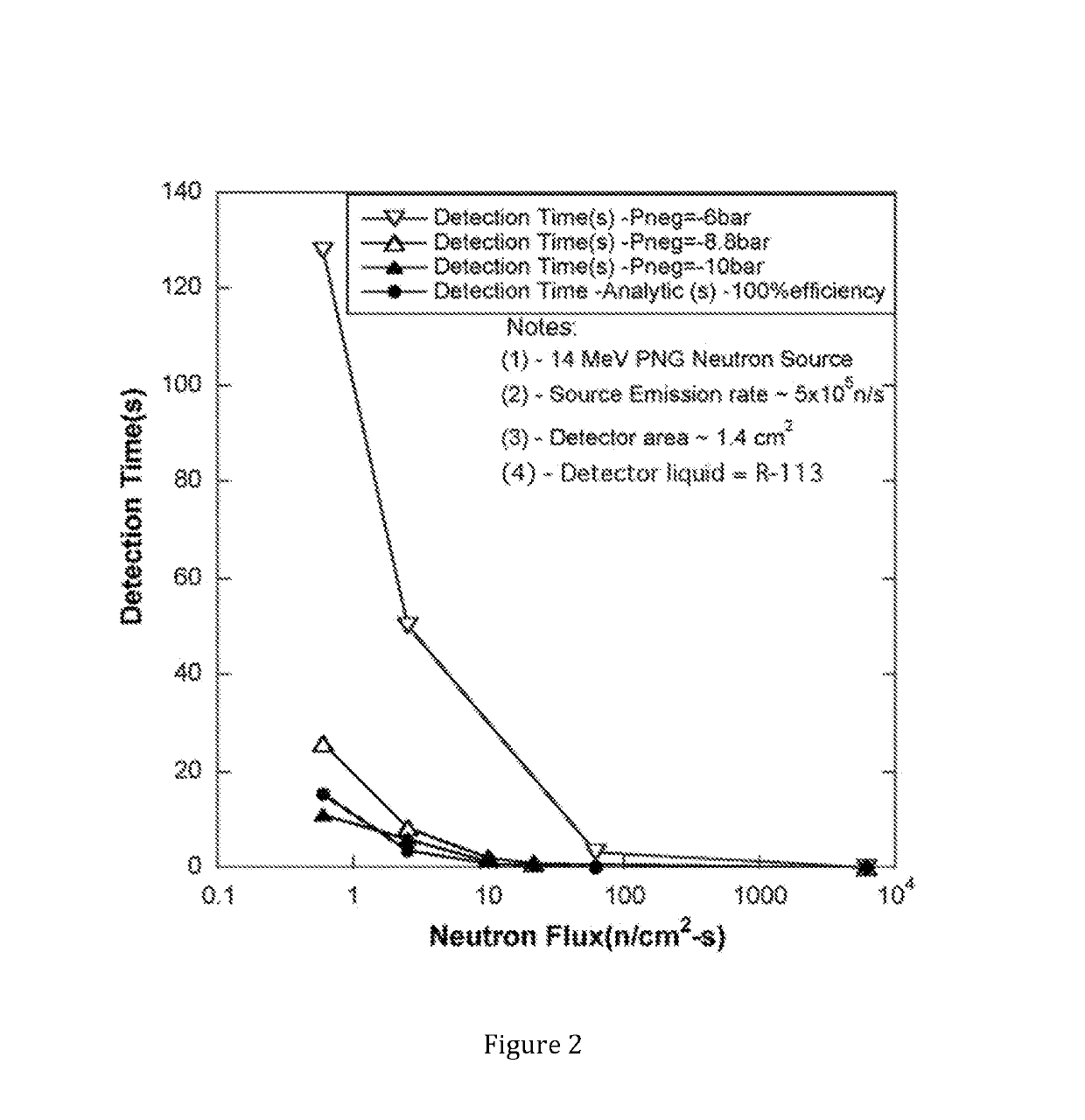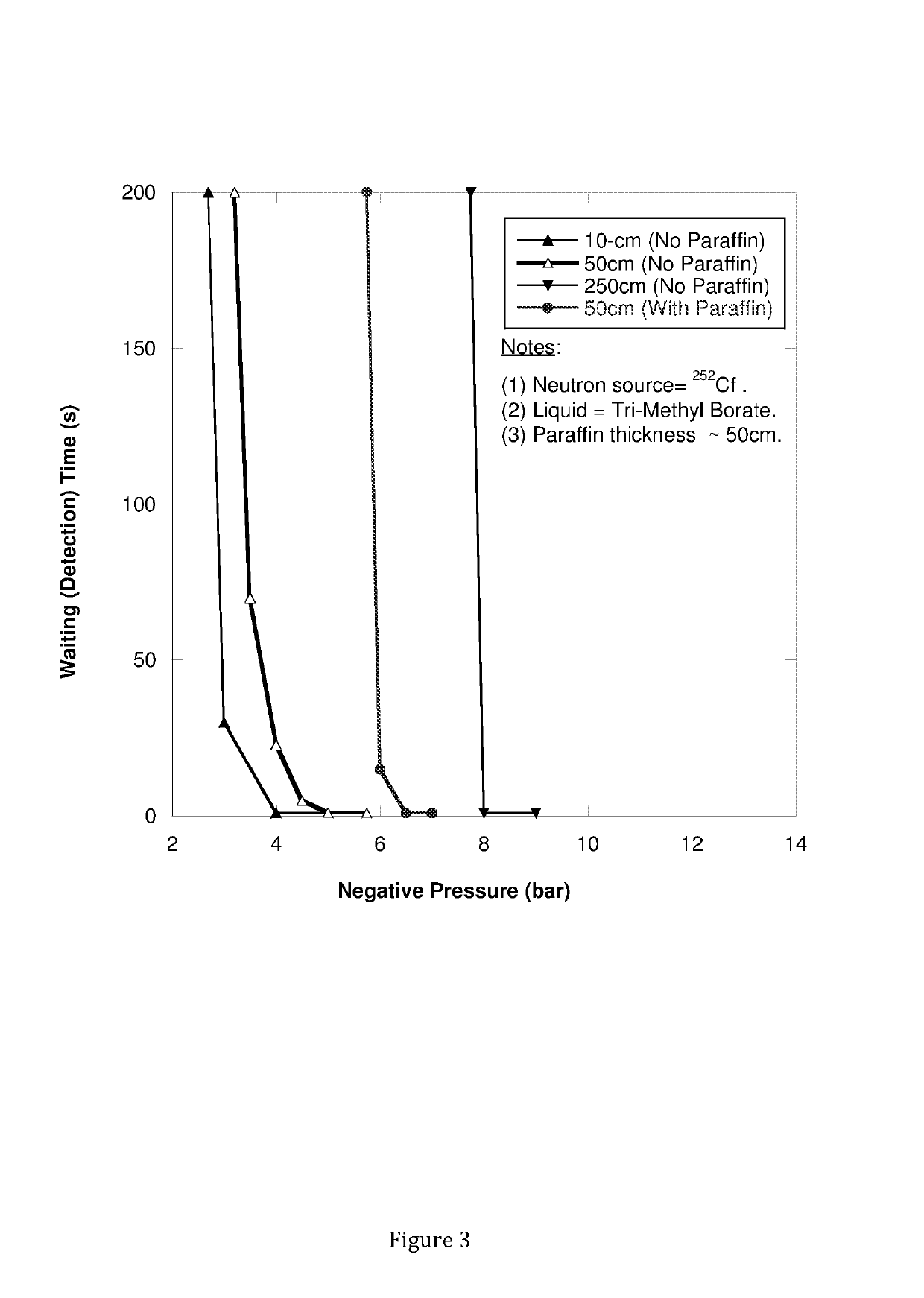Compositions and methods for detecting radiation
a technology of radiation detection and composition, applied in the field of compositions and methods for detecting radiation, can solve the problems of not enabling a single system to respond to these needs, and inability to deposit enough energy within 2r, and achieve the effect of enhancing bearing wear and acceleration rate as high
- Summary
- Abstract
- Description
- Claims
- Application Information
AI Technical Summary
Benefits of technology
Problems solved by technology
Method used
Image
Examples
example 1
[0169]Example 1 demonstrates: CTMFD detection using PFO for neutron detection and gamma-blind neutron dosimetry. The CTMFD was used to detect a spontaneous fission source (252Cf) and to compare its performance against an industry standard neutron monitor known as SNOOPY®. The CTMFD's sensitive volume bulb sine was about 4 mL.
[0170]Detection of 252Cf using acetone and PFO was compared with the SNOOPY®. At the same Pneg state (e.g., −8 bar), the use of PFO vs acetone enables 100% improvement in detection efficiency. To avail of the same type of detection efficiency as with PFO (at −8 bar) required a Pneg of about −10 bar for acetone. The CTMFD (4 mL sensitive volume) performance using PFO as the sensing fluid is shown in FIG. 5.
[0171]The fluid in the CTMFD detector was thoroughly degassed using known techniques.
[0172]The CTMFD can be used as a neutron dosimeter that is also simultaneously blind to gamma photons unlike state-of-art neutron dosimeters based on BF3 or He-3 which are not....
example 2
[0178]This example demonstrates uranium detection in aqueous media at trace (pCi / L) levels with a CTMFD. Such determination is required for municipalities for alpha emitters such as U, Ra, etc. in water, and also, for assessing the possible radiological contamination at nuclear facilities by assessing for such trace concentrations in an individual's urine (which is predominantly (over 95%->9,500 g / L) composed of water, and small quantities of other materials (chiefly: urea—9.3 g / L; chloride—1.9 g / L; sodium—1.17 g / L; potassium—0.75 g / L; creatinine—0.67 g / L). A suitable form of uranium that is water soluble was chosen for monitoring about 10 pCi / L of U in water within an hour compared with alternate techniques which can take days to weeks. In this case, Uranyl Nitrate (UN) was chosen. It is impractical to test for pCi / L concentration bearing water in TMFDs of sizes in the 1 mL to 100 mL volume range. Monitoring for actinides like U requires their concentration to more manageable level...
example 3
[0190]This example demonstrates a CTMFD sensor in large array form that meets or exceeds declared Federal goals for SNM detection. This example demonstrates an array of detectors fit within a 1 m×1 m×1 m enclosure that can detect shielded 252Cf neutrons with an efficiency approximating 100% higher than that for known He-3 filled detector banks. That is, to enable a detection efficiency (AεCf)>1,200 cm2. Based on experiments using isopentane and trimethyl borate, a full scope 3-D simulation was performed to ascertain for the design of an array of CTMFD detectors of a given size (600 mL each) that provides AεCf′>1.200 cm2. FIG. 9 depicts the array form in which CTMFDs may be placed to achieve this goal. Table xx below summarizes the results of the tradeoff studies for CTMFDs using either isopentane or trimethyl borate as the sensing fluids, isopentane (C5H12) is to be used to sense fast (MeV energy) neutrons, whereas, trimethyl borate (which includes 10B isotope with its relatively la...
PUM
 Login to View More
Login to View More Abstract
Description
Claims
Application Information
 Login to View More
Login to View More - R&D
- Intellectual Property
- Life Sciences
- Materials
- Tech Scout
- Unparalleled Data Quality
- Higher Quality Content
- 60% Fewer Hallucinations
Browse by: Latest US Patents, China's latest patents, Technical Efficacy Thesaurus, Application Domain, Technology Topic, Popular Technical Reports.
© 2025 PatSnap. All rights reserved.Legal|Privacy policy|Modern Slavery Act Transparency Statement|Sitemap|About US| Contact US: help@patsnap.com



